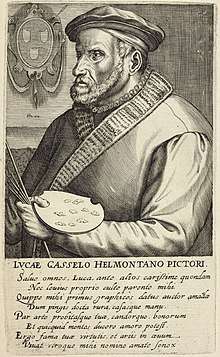Lucas Gassel

Lucas Gassel (c. 1490 – 1568) was a Flemish Renaissance painter.
Biography
Born in Helmond, Lucas Gassel is among the painters who have emigrated from northern Netherlands to build careers in Flanders and Brabant. According to Karel van Mander, he was trained in Antwerp before working in Brussels. Karel van Mander also tells us that he was greatly admired by Dominicus Lampsonius, who was also his friend.[1]. He painted landscapes and architectural studies without regard for realistic depiction. In the foreground of his landscapes with rivers and mountains, and of his cityscapes with palaces and leisure gardens, his staffage pose in parables from the Bible, classical subjects, courtly leisure pursuits or every day life. These characters are mainly pretexts to present the panoramic view in which they are included. He managed to mix fantastic rocky masses and a refined world of sweetness. His imagined world is made of smooth artwork and subtle glaze (Cf Luc Serck).
He followed Herri met de Bles but with a distinct style, which the Belgian national library summarizes with "he accentuates the graphic aspect, prefers matte colors, avoids too much accuracy and the overload of details, which helps to give to his work a more modern aspect."[2]
Trivia
Notes
- ↑ (in Dutch) Lucas Gassel in Karel van Mander's Schilder-boeck, 1604, courtesy of the Digital library for Dutch literature
- ↑ (In French) : http://balat.kikirpa.be/peintres/Detail_notice.php?id=2435
- ↑ Old Master Painting by Lucas Gassel that Shows Importance of Tennis http://www.alaintruong.com/archives/2011/01/10/20094505.html
- ↑ Old masters auction https://www.bonhams.com/auctions/18875/lot/114/
References
- Hans Devisscher (1966) Gassel, Lucas. In: The dictionnary of art. Macmillan, London
- W. Gibson, (1989) "Mirror of the Earth", The World Landscape in Sixteenth-Century Flemish Painting, Princeton
- In French : Luc Serck (1990) Henri Bles et la peinture de paysage, UCL.
- Lucas Gassel on Artnet
External links
